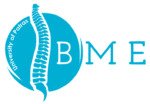| Code | A5 |
| Type | Compulsory |
| Semester | A |
| ECTS credits | 4 |
| Teaching Staff | Georgios Athanassiou, Associate Professor, Dept. of Mechanical Engineering & Aeronautics
Despina Deligianni, Associate Professor, Dept. of Mechanical Engineering & Aeronautics Dimosthenis Mavrilas, Associate Professor, Dept. of Mechanical Engineering & Aeronautics |
The aims of the course are
- To make the student familiar with the main measurement and modelling methods for the characterization of the musculo-skeletal system, based on basic mechanical physics concepts and rigid body assumption.
- To provide the student with basic knowledge necessary for biomechanical modelling of musculo-skeletal and cardio-circulatory problems by applying basic continuum mechanics and fluid-dynamics concepts, integrated with modelling approaches originally developed for the special application to mechanics of biologic tissues.
The contents of the course in brief are:
- Introduction to biomechanics: brief history of biomechanics.
- Kinematics in biomechanics. Statics and dynamics in biomechanics: 2-D and 3-D models of the musculoskeletal system.
- Human motion analysis.
- Deformable body mechanics: stress, strain, constitutive equations (elastic and viscous materials, etc.).
- Skeletal biomechanics: bone and soft connective tissues (ligament, tendon, cartilage).
- Functional adaptation and mechanobiology.
- Muscle modelling.
- Hemodynamics: basic concepts of fluid dynamics. Vascular system modelling. Mechanics of the cardiac muscle: Mechanical characteristic of the heart as deformable tissue, pressurised structure and muscle.
